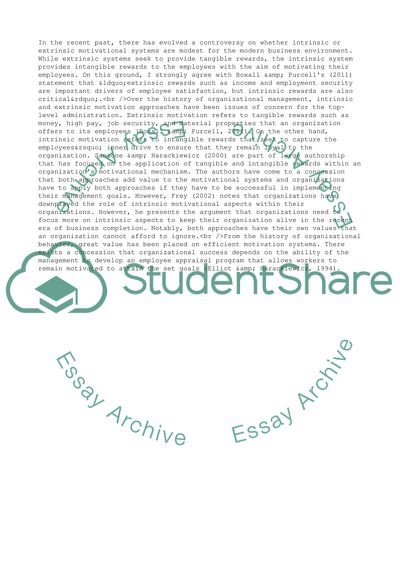Cite this document
(Extrinsic and Intrinsic Rewards Essay Example | Topics and Well Written Essays - 2500 words, n.d.)
Extrinsic and Intrinsic Rewards Essay Example | Topics and Well Written Essays - 2500 words. https://studentshare.org/management/1850275-extrinsic-rewards-such-as-income-and-employment-security-are-important-drivers-of-employee-satisfaction-but-intrinsic-rewards-are-also-critical-boxall-purcell-2008-discuss-this-statement-with-reference-to-the-marketing-services-sector-using-ex
Extrinsic and Intrinsic Rewards Essay Example | Topics and Well Written Essays - 2500 words. https://studentshare.org/management/1850275-extrinsic-rewards-such-as-income-and-employment-security-are-important-drivers-of-employee-satisfaction-but-intrinsic-rewards-are-also-critical-boxall-purcell-2008-discuss-this-statement-with-reference-to-the-marketing-services-sector-using-ex
(Extrinsic and Intrinsic Rewards Essay Example | Topics and Well Written Essays - 2500 Words)
Extrinsic and Intrinsic Rewards Essay Example | Topics and Well Written Essays - 2500 Words. https://studentshare.org/management/1850275-extrinsic-rewards-such-as-income-and-employment-security-are-important-drivers-of-employee-satisfaction-but-intrinsic-rewards-are-also-critical-boxall-purcell-2008-discuss-this-statement-with-reference-to-the-marketing-services-sector-using-ex.
Extrinsic and Intrinsic Rewards Essay Example | Topics and Well Written Essays - 2500 Words. https://studentshare.org/management/1850275-extrinsic-rewards-such-as-income-and-employment-security-are-important-drivers-of-employee-satisfaction-but-intrinsic-rewards-are-also-critical-boxall-purcell-2008-discuss-this-statement-with-reference-to-the-marketing-services-sector-using-ex.
“Extrinsic and Intrinsic Rewards Essay Example | Topics and Well Written Essays - 2500 Words”. https://studentshare.org/management/1850275-extrinsic-rewards-such-as-income-and-employment-security-are-important-drivers-of-employee-satisfaction-but-intrinsic-rewards-are-also-critical-boxall-purcell-2008-discuss-this-statement-with-reference-to-the-marketing-services-sector-using-ex.


